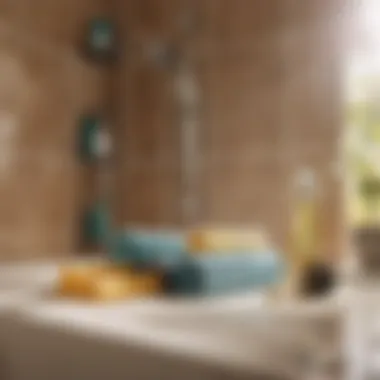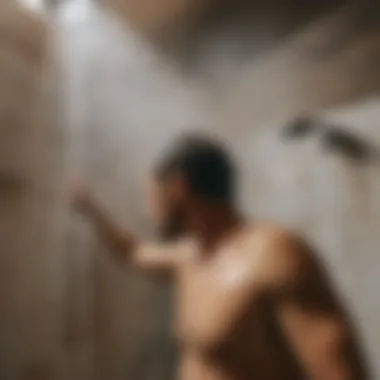Materials:
- Waterproof membrane: 3 rolls (each measuring 6ft x 4ft) for optimal coverage.
- Shower pan liner: 1 thick liner to create a watertight seal.
- Cement backer board: 6 sheets (measuring 3ft x 5ft each) for stability and waterproofing.
- Tile adhesive: 2 buckets for tile installation.
- Ceramic tiles: 50 sq ft of your preferred tile choice for a customized look.
- Grout: 3 bags for sealing tiles and preventing water damage.
- Shower fixtures: Complete set including showerhead, knobs, and drain cover.
- Silicone caulk: 3 tubes for sealing edges and joints.
DIY Steps:
- Removing Existing Shower: Start by turning off water supply, disconnecting fixtures, and demolishing existing walls and shower base carefully to avoid damage to surrounding areas.
- Prepping the Space: Ensure proper ventilation, inspect plumbing for any issues, and prepare the floor for the installation of a new shower pan.
- Installing Waterproof Membrane: Cut and apply the membrane on walls and floor, overlapping seams for maximum protection against moisture.
- Setting Up Shower Pan: Place the shower pan liner over the subfloor, securing it properly and sloping it towards the drain for efficient water flow.
- Installing Backer Board: Cut and attach backer boards to walls, ensuring a secure and waterproof surface for tiling.
- Tiling the Shower: Apply tile adhesive, place ceramic tiles in desired pattern, and allow them to set before grouting for a polished finish.
- Adding Fixtures: Install shower fixtures according to manufacturer's instructions, including showerhead, knobs, and drain cover.
- Sealing Joints and Edges: Use silicone caulk to seal edges where tiles meet walls/floor and around fixtures for a watertight seal.
Technical Aspects:
- Tools: Trowel, notched trowel, tile cutter, grout float, level, drill, screws, utility knife.
- Timing: Plan for at least 2-3 days to complete the project, allowing time for adhesive and grout to set.
- Critical Techniques: Ensure proper waterproofing by overlapping membrane seams, use spacers for evenly spaced tiles, and follow manufacturer guidelines for fixture installation.
DIY Project Process:


- Detailed Installation Method: Follow step-by-step instructions for each stage ensuring accurate measurements and proper assembly of materials for a sturdy and functional shower.
- Key Techniques and Timings: Pay attention to leveling tiles, allowing adhesive to cure before grouting, and testing fixtures before finalizing installation.
- Troubleshooting Tips: In case of uneven tiles, adjust with spacers; for leaky fixtures, reinforce with additional silicone caulk.
Introduction


In the realm of home improvement projects, replacing a shower holds a significant position due to its impact on both functionality and aesthetics. The shower is a focal point in any bathroom, serving as a daily retreat for relaxation and rejuvenation. Understanding the intricacies of proper shower replacement ensures that this essential fixture continues to serve its purpose effectively while elevating the overall look and feel of the bathroom.
Proper shower replacement is more than just a superficial upgrade; it involves a combination of technical knowledge, design considerations, and practical skill. By delving into this guide, homeowners can gain a comprehensive understanding of the process, empowering them to make informed decisions and achieve a successful outcome. Whether embarking on a DIY journey or enlisting the help of professionals, the insights provided here will serve as a valuable resource throughout the project.
Understanding the Importance of Proper Shower Replacement
When it comes to upgrading or renovating a bathroom, the shower stands out as a key element that can significantly impact the overall ambiance and functionality of the space. Proper shower replacement ensures that issues such as leaks, mold growth, or outdated fixtures are addressed effectively, promoting a healthier and more appealing bathroom environment.
One crucial aspect of proper shower replacement is the consideration of water damage. Over time, showers are prone to wear and tear, with water infiltration causing structural damage and compromising the integrity of the bathroom. By replacing the shower correctly, homeowners can prevent costly repairs down the line and maintain the structural integrity of their home.
Furthermore, modernizing the shower through replacement allows individuals to embrace new design trends and technologies. Upgrading to features such as rain showerheads, digital temperature controls, or energy-efficient fixtures not only enhances the aesthetic appeal of the bathroom but also improves convenience and comfort for users.
In essence, understanding the importance of proper shower replacement goes beyond surface-level aesthetics; it encompasses functionality, sustainability, and the overall well-being of the home environment.
Assessing the Need for Shower Replacement
Before embarking on a shower replacement project, it is essential to assess the current state of the existing shower to determine if replacement is indeed necessary. Several indicators may signal the need for a shower replacement, ranging from cosmetic issues to functional deficiencies.
Cosmetically, signs of wear and outdated aesthetics such as discolored surfaces, cracked tiles, or worn-out fixtures may prompt homeowners to consider a shower replacement to rejuvenate the look of the bathroom. Additionally, changes in personal style preferences or design trends may motivate individuals to upgrade their shower to align with modern aesthetics.
From a functional standpoint, issues such as persistent leaks, mold growth, or inefficient water usage are red flags that point towards the necessity of a shower replacement. Addressing these functional concerns through timely replacement not only improves the performance of the shower but also enhances the overall safety and hygiene of the bathroom.
Assessing the need for shower replacement involves a thorough evaluation of both aesthetic and functional aspects, enabling homeowners to make informed decisions about whether to proceed with the replacement process. By identifying and addressing existing issues proactively, individuals can embark on a shower replacement project with confidence, knowing that it will yield a transformative and long-lasting impact on their bathroom space.
Preparation Stage


In the process of replacing a shower, the Preparation Stage plays a crucial role in ensuring a smooth and successful project execution. This stage sets the foundation for the entire renovation process, laying the groundwork for the demolition and installation phases. By focusing on meticulous planning and organization during the Preparation Stage, homeowners can minimize potential setbacks and errors, ultimately saving time and resources.
Gathering Necessary Tools and Materials
Before embarking on the shower replacement journey, the first step in the Preparation Stage is gathering the necessary tools and materials. This step is essential to ensure that you have everything at hand to complete the project efficiently. Common tools required may include a utility knife, pry bar, screwdriver, hammer, and caulking gun, while materials like new shower fixtures, waterproofing membrane, grout, and silicone sealant are essential for the installation process.
Turning Off Water Supply and Electricity
Safety is paramount during a shower replacement project, making it critical to turn off the water supply and electricity before starting any work. Cutting off the water ensures that there are no leaks or accidental flooding during the demolition and installation stages. Similarly, switching off the electricity prevents any electrical hazards in wet areas, reducing the risk of accidents and ensuring a secure working environment.
Protecting Surrounding Areas from Damage
To prevent damage to surrounding areas during the renovation, it is important to take adequate measures to protect floors, walls, and fixtures. Use heavy-duty drop cloths or plastic sheeting to cover floors and furniture, masking tape to shield walls from scratches or dents, and protective covers for plumbing fixtures. By safeguarding your surroundings, you can maintain cleanliness and organization throughout the shower replacement process, minimizing cleanup time and enhancing the overall outcome.
Demolition Process
In the grand scheme of shower replacement, the demolition process plays a vital role that sets the stage for the transformation ahead. A meticulous approach to demolition ensures a smooth progression towards the installation phase. The demolition process involves the careful removal of existing fixtures and structures, paving the way for a fresh start.
Removing Existing Shower Fixtures
Removing existing shower fixtures is the initial step in the demolition process. It requires precision and attention to detail to avoid causing unnecessary damage. Begin by disconnecting the water supply and electricity to the shower area to ensure safety. Unscrew and detach the showerhead, faucet handles, and any other accessories attached to the shower walls. Proper labeling of each part helps in easier reassembly later on.
Breaking Down Walls and Enclosure
Breaking down walls and enclosure is a significant aspect of the demolition process. It involves careful dismantling of the shower walls and enclosure to create a clean slate for the new installation. Use appropriate tools such as a sledgehammer and a crowbar to carefully remove tiles, drywall, or any other materials forming the shower enclosure. Dispose of debris responsibly to maintain a tidy worksite.
Installation Phase
The Installation Phase is a critical stage in the shower replacement process outlined in this guide. It encompasses a series of precise steps that are essential for ensuring the successful establishment of a new shower system. This section focuses on executing the meticulous tasks involved in setting up the new shower components effectively.
Installing New Shower Pan
The installation of a new shower pan is a foundational element in creating a durable and functional shower unit. This process starts by carefully positioning the shower pan base in place and ensuring it is level to promote proper water drainage. Subsequently, the shower pan is securely attached to the subfloor, guaranteeing stability and longevity for the shower structure.
Moreover, sealing the connections between the shower pan and the walls is crucial to prevent water leakage, thereby preserving the integrity of the entire installation. Attention to detail during the installation of the shower pan is paramount to avoid potential issues such as water damage and structural instability in the future.
Setting Up Wall Surrounds
The process of setting up wall surrounds involves meticulously placing and securing the walls around the shower area. This step not only contributes to the aesthetic appeal of the shower but also serves functional purposes such as water containment and protection of the surrounding walls from moisture.
Selecting high-quality materials for the wall surrounds is essential in ensuring durability and resistance to water damage. Precise measurement and cutting of the wall panels are imperative for a seamless fit and professional finish. Properly installed wall surrounds not only enhance the appearance of the shower but also simplify maintenance and cleaning tasks.
Connecting Plumbing and Drainage System
The connection of the plumbing and drainage system is a critical aspect of the installation phase, as it determines the proper functioning of the new shower. It involves aligning the drain pipe with the shower pan, ensuring a secure and watertight connection to prevent leaks and potential water damage.
Careful adherence to local plumbing codes and regulations is necessary to guarantee compliance and safety. Thorough testing of the plumbing system post-installation is essential to identify and rectify any issues before completing the installation phase. Properly connected plumbing and drainage systems are fundamental to the overall efficiency and performance of the new shower system.
Finishing Touches
In the realm of shower replacement, the Finishing Touches segment serves as the crowning glory of the entire project. Once the installation work is completed, paying meticulous attention to these details is crucial for achieving a polished and functional end result. Emanating a sense of finesse and precision, the Finishing Touches segment elevates the overall aesthetic and functionality of the new shower.
Sealing Joints and Fixtures
Sealing joints and fixtures plays a pivotal role in ensuring the longevity and durability of the newly replaced shower. Properly sealed joints prevent water leakage, mold growth, and structural damage. Utilizing high-quality sealants and adhesives, such as silicone caulking, creates a watertight seal that fortifies the shower structure against moisture infiltration. It is imperative to meticulously inspect and seal every joint and fixture to guarantee a water-resistant and secure shower enclosure.
Testing for Leaks and Proper Functionality
After completing the installation process and sealing all joints, thorough testing for leaks and proper functionality is imperative. Conducting a series of rigorous tests, including pressure tests and visual inspections, ensures that the new shower functions seamlessly. Checking for leaks at every connection point and assessing the drainage system's efficiency guarantees a leak-free and properly functioning shower unit. Rigorous testing provides peace of mind that the shower is structurally sound and ready for everyday use.
Adding Aesthetic Enhancements
Adding aesthetic enhancements serves as the cherry on top of a well-executed shower replacement project. From selecting stylish hardware and fixtures to incorporating decorative tiles or accents, enhancing the visual appeal of the shower space transforms it into a luxurious sanctuary. Consider adding niche shelves for storage, installing a rainfall showerhead for a spa-like experience, or incorporating a distinctive tile pattern to personalize the space. Aesthetic enhancements not only elevate the visual charm of the shower but also reflect the homeowner's unique style and preferences, creating a haven of relaxation and indulgence.





